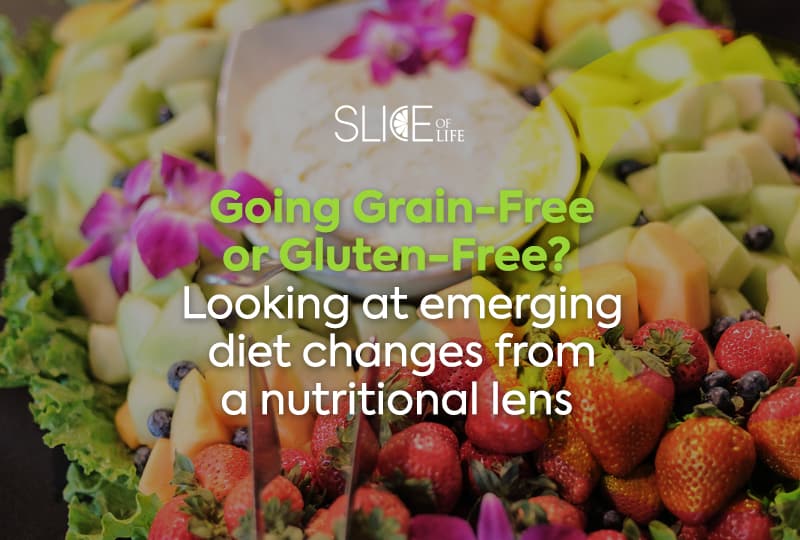Not sure when exactly it started, but the ban on bread has slowly crept up on us. Well, not really, but the focus on grain-free or gluten-free diets is definitely having a moment. So now, maybe more than ever, is a great time to look at what exactly is a grain-free diet, what is a gluten-free diet and how either can impact your health.
Grain-free diets
What does it mean to go grain-free? Healthline sums things up in their article “Is a Grain-Free Diet Healthy? Everything You Need to Know.” Simply put, a grain-free diet means a person avoids all grains. This includes grains containing gluten, such as wheat, spelt, barley, rye and triticale. It also includes grains that do not have gluten, such as dried corn, millet, rice, sorghum and oats.
Oddly enough, fresh corn is not considered a grain, but dried corn is. So, corn flour is also to be left out of a grain-free diet. Some people might take things even further by avoiding food derived from grains, such as high fructose corn syrup. This is not necessarily a requirement, however.
A grain-free diet typically means cutting out or finding alternative versions of many favorite foods like bread, pasta, muesli, oatmeal, rice cakes, cereals, pastries and cookies. Pseudocereals, such as quinoa, amaranth and buckwheat, are permitted, though in small portions. It tends to lend itself to a low-carb lifestyle, but if you want more carbs in your diet, you can get them from other sources like fruit, legumes and starchy veggies.
This diet doesn’t restrict non-grain food, so you can eat those as you normally would. In general, try to avoid over-processed foods.
A note on gluten-free diets
A gluten-free diet shares similarities to a grain-free diet, but it is not necessarily the same. A gluten-free diet excludes all food containing gluten, a protein found in wheat and many other grains. Johns Hopkins Medicine broke it down in their article “Gluten-Free Diet: Is It Right for Me?”
Gluten-free diets are best suited for people with celiac disease, gluten sensitivity or a wheat allergy. Gluten must be avoided for those diagnosed with celiac, an autoimmune disorder shared by roughly 1% of the Western World that makes the body see the gluten protein as a threat and sends the immune system into hyperdrive. Gut inflammation is a common response, which can also cause nutrient deficiencies and other digestive complications. People with gluten sensitivity often report disconcerting symptoms like stomach pain, bloat, constipation, diarrhea, eczema, headaches and tiredness when eating grains.
Gluten-free diets aren’t necessarily shown to have much of an added health benefit for people without one of the above conditions, other than it will lead them away from more processed foods. The last thing to note if you are avoiding gluten is that it can hide in foods you wouldn’t expect, as it is often added to processed foods for texture. It can hide in soy sauce, candy, makeup and more, so read your labels religiously.
Potential grain-free dietary benefits
Coming back to the question of whether to go grain-free, going grain-free does have some merits to consider. If inflammation is a concern, cutting grains out can help, as grains can contribute to inflammation. On the other hand, whole grains can offer anti-inflammatory benefits. If you do not have a health need to avoid gluten, it might not be necessary to go completely grain-free.
Some people have noticed going grain-free has helped in weight loss, so that could be a deciding factor, but again, it may be a case of limiting grains versus complete elimination. It depends on your fitness goals and caloric intake. This type of diet can also help with high blood sugar levels, as grain-rich diets often contain a lot of carbs that turn to sugar during digestion. Fiber-rich whole grains can help stabilize and prevent blood sugar spikes too, so that is another way to go if cutting out all grains doesn’t make sense for you.
Possible downsides to grain-free
Like most major dietary changes, grain-free comes with some challenges that may make it unfeasible for some people. For example, if you don’t have fiber-rich grains in your diet, it could lead to constipation issues. You would need to increase your take of other fiber-rich foods such as certain fruits, vegetables, nuts, seeds and legumes to mitigate that.
Nutrient intake is also a valid concern. Whole grains provide a whole host of needed nutrients, such as fiber, iron, magnesium, phosphorus, manganese and selenium. This is not true of processed grains whose bran and germ have been removed, however. If you choose to take on a grain-free diet, you will need to compensate for these nutrients in other forms. Pseudocereals like quinoa, amaranth and buckwheat contain many of the same nutrients as whole grains. Fruits, veggies, nuts, seeds, legumes, meat, eggs and fish can also help make up the difference.
Lastly, a full grain-free diet can be restrictive and hard to maintain. The evidence so far suggests that many benefits of a grain-free diet can be achieved without necessarily cutting out the entire food group. It can also be concerning to unnecessarily fixate on cutting out a whole food group if it isn’t necessary for you, as it can fuel disordered eating habits. Before implementing this or any other significant dietary change, it is necessary to fully understand how the new diet will fit into your life and if it is truly beneficial to you.
Learn more about Life U’s Nutrition programs at life.edu/academic-pages/college-of-graduate-and-undergraduate-studies/nutrition-bs/.
Slice of LIFE is an invitation to and extension of everything happening at Life University. Whether you are a current student, a potential freshman or a proud alum, Slice of LIFE can help keep you connected to your academic community. Know of a compelling Life U story to be shared, such as a riveting project, innovative group or something similar? Let us know by emailing Marketing@life.edu.


Social Media